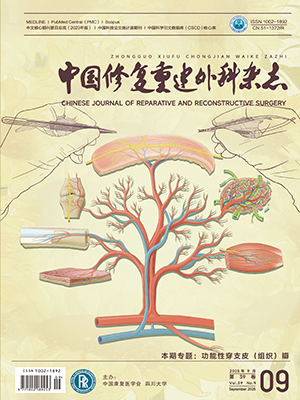Objective To observe the effect of local injection of vascular endothel ial growth factor (VEGF) and VEGF antibody on the wear particle-induced osteolysis in the mouse air pouch model and to investigate the role of VEGF in the process of aseptic loosening of prosthesis. Methods The stem of metal hip prosthesis was obtained from the revision surgery.
Metallic wear particles were made by vacuum ball mill ing. Wear particles suspension was prepared into the concentration of 10 mg/mL with PBS. Fifty female Kunming mice (aged 8-10 weeks, weighing about 25 g) were selected. Of 50 mice, 10 were used as the donors of bone graft, the other 40 were equally divided into control group (group A), particle group (group B), VEGF group (group C), and VEGF inhibited group (group D). Air pouches were made on the back of 40 mice by injecting sterile air subcutaneously. At 8th day, a graft of calvaria from the donor mice was implanted in air pouch. In groups B, C, and D, 0.5 mL wear particles suspension was injected into the air pouches, and in group A, 0.5 mL PBS was injected. Once a day at 6th and 7th days during the air pouch preparation and one time every two days after bone implantation, 0.2 mL recombinant human VEGF (rhVEGF) and VEGF antibody (Bevacizumab) were injected into the air pouches in groups C and D, respectively. In group A and group B, 0.2 mL sal ine was injected. Pouch tissues and bone were harvested at 2 weeks after bone implantation for HE staining, real-time fluorescent quantitative PCR and ELISA analyses. Results All mice survived to the end of experiment. The gross observation showed that there were mild redness, swell ing, and less neovascularization in air pouches in group A. There were obvious redness, swell ing, and more exudative and neovascularization in groups B, C, and D, most obvious in group C, the next in group B, then in group D. The histological and molecular biological analysis showed that inflammatory responses and osteolysis were obvious in group B and the pouch membrane thickness, the cell density, transforming growth factor α, interleukin 1β, and VEGF were significantly higher than those in group A (P lt; 0.05). The inflammatory responses and osteolysis were most
obvious in group C and the above-mentioned indexes were significantly higher than those in group B (P lt; 0.05). There were some inflammatory responses and osteolysis in group D, but the indexes were significantly lower than those in group B (P lt; 0.05) and were significantly higher than those in group A (P lt; 0.05). Conclusion VEGF can promote inflammatory responses and osteolysis in aseptic loosening of prosthesis. VEGF antibody can effectively inhibit wear particle-induced osteolysis.
Citation: DAI Min,ZHONG Yanchun,ZONG Ling,YANG Xiaogang,CHENG Ming,YANG Kanghua. INHIBITORY EFFECTS OF VASCULAR ENDOTHELIAL GROWTH FACTOR ANTIBODY ON WEAR PARTICLEINDUCED OSTEOLYSIS. Chinese Journal of Reparative and Reconstructive Surgery, 2012, 26(6): 647-651. doi: Copy
Copyright © the editorial department of Chinese Journal of Reparative and Reconstructive Surgery of West China Medical Publisher. All rights reserved




